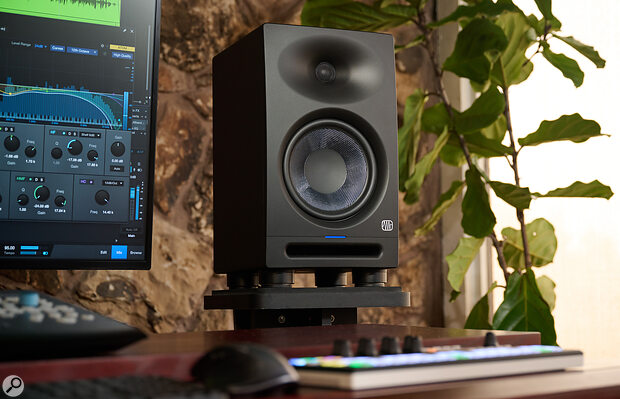The Eris series of monitors continues to offer remarkable value for money.
The new Eris Studio series from PreSonus comprises three models of differing sizes, based around four‑, five‑ and eight‑inch woofers, and it’s the largest of the three we’re reviewing here.
There’s nothing at all unusual about the physical format of them — in fact they follow the most common monitor format found in smaller studios and home facilities, being a two‑way active system in a ported cabinet. In order to control the dispersion of the tweeter at the crossover point and to maximise the width of the sweet spot, the tweeter sits in an EBM (Elliptical Boundary Modelled) waveguide, which has a 120 x 60‑degree (horizontal x vertical) dispersion. There have been earlier two‑way models of a similar format in the Eris range, and they have been well‑received at their price point, but this new Studio model has had a significant revamp and features a woven‑composite cone woofer and a 1.25‑inch, soft‑domed silk tweeter. The design aim was to provide a richer, more tightly controlled low end and detailed highs, which I think it would be fair to say PreSonus have achieved. The woven‑composite cone construction combines light weight with mechanical stiffness.
These speakers are bi‑amped, crossing over at 3.5kHz, with a total of 140 Watts of amplifier power (75W for the lows, 65W for the highs) and cover the 35Hz‑20kHz frequency range, though no tolerances are supplied. A maximum SPL of 106dB peak at one metre is quoted.
Internally braced, the cabinets are made from MDF with a black vinyl veneer, with the front‑exiting reflex port sited close to the bottom of the baffle. Slightly rounded cabinet edges, speaker aperture and port exit help avoid cabinet‑edge diffraction. All the controls and connectors are on the metal rear panel and have the same layout and format as those found on the more costly coaxial Eris Pro 8s. An LED bar on the front of the speaker shows white in standby mode and glows blue when the speaker is active.
The input options are all analogue and offer a choice of unbalanced RCA phono, TRS balanced quarter‑inch jack or balanced XLR, with an overall input volume control. Acoustic tuning controls are available to compensate for placement relative to boundaries: an Acoustic Space switch allows for full‑, half‑ and quarter‑space placement (LF trim of 0, ‑2 and ‑4 dB respectively), plus separate HF and mid controls variable over ±6dB. There’s also a high‑pass filter with options for off, 80Hz or 100Hz. Protection is built in to filter out RF and provide output‑current limiting and over‑temperature protection. There’s also a soft‑start circuit to prevent power‑on or ‑off thumps, as well as a subsonic filter to keep out harmful ultra‑low frequencies.
In Use
My tests were carried out in my own studio space, well away from walls and corners, alongside my old faithful Event Opals. Thought the Eris Studio 8s cost around the same as the tax on the Opals, they certainly didn’t disgrace themselves. Indeed, by dialling back the midrange control just slightly, I managed to get a pretty good timbral match between the two, though the Opals still won out on depth of bass, with a little more low‑end tightness and a better overall sense of focus in the midrange. Nevertheless, the bass end of the Eris Studio 8s is still punchy and sounds tighter than I’ve heard from many similarly sized monitors in the sub‑$£1000 bracket, while the highs are clear and detailed without undue harshness thanks to that silk‑domed tweeter. The sweet spot is usefully wide, the stereo imaging combines a strong sense of width with a solid centre image, and there’s a good sense of depth to the sound stage. Once I’d tamed the slightly forward mids using the rear‑panel EQ, the results were most encouraging.
Given the affordability of the Eris Studio 8s, I have to say that I am impressed.
All monitors are a compromise based on cost, the laws of physics and design expertise, but given the affordability of the Eris Studio 8s, I have to say that I am impressed. Their creditable price:performance ratio makes them a good fit for home studios, so if you’re in the market for a pair of eight‑inch monitors in this price range, then the Eris Studio 8s should definitely be on your shortlist.
Summary
The Eris Studio 8s provide a reliable standard of monitoring for home studio owners whose budgets are restricted.
Information
£498 per pair including VAT.


